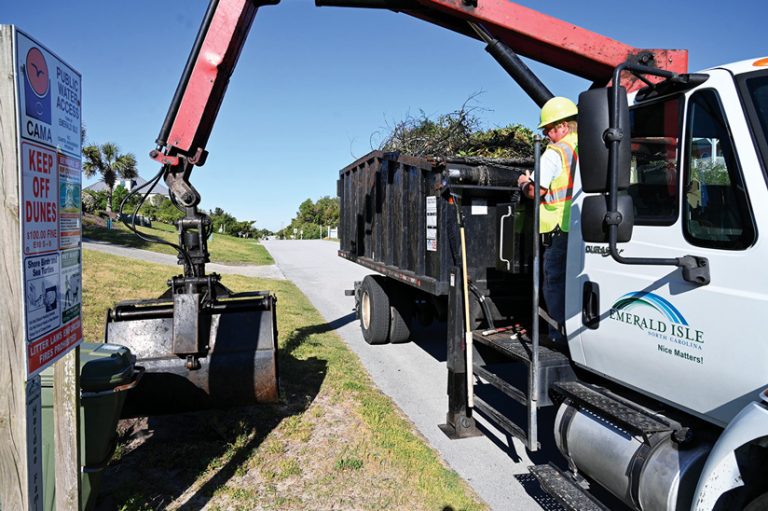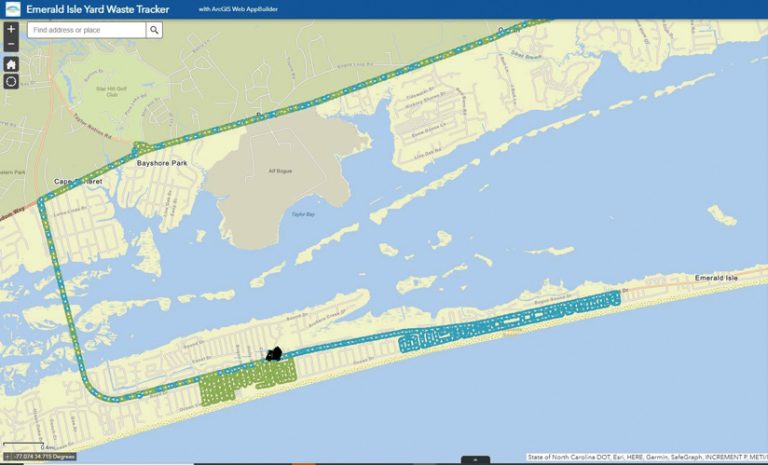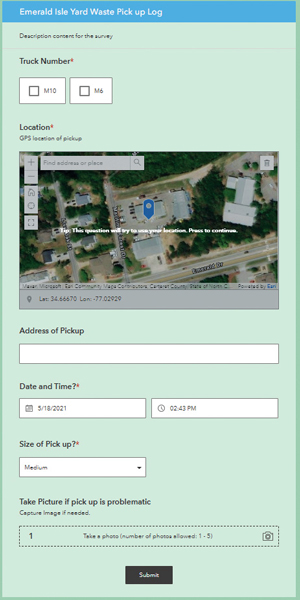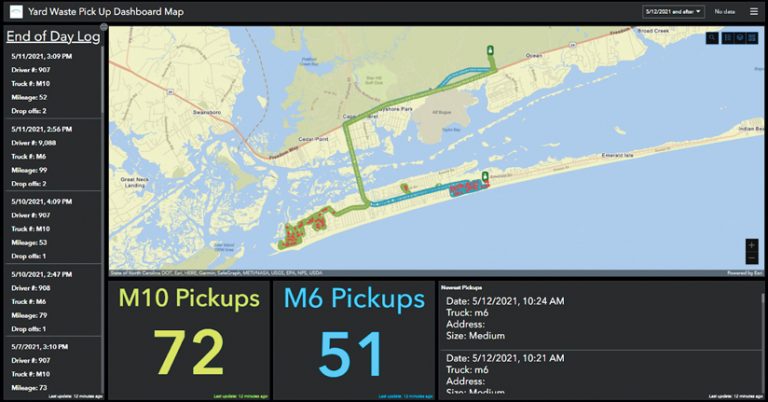In Emerald Isle, North Carolina, residents now have a real-time, bird’s-eye view of where yard debris trucks are traveling along their route at any given time.
The Emerald Isle Yard Waste Tracker displays the location of the town’s two yard waste trucks on a map as the vehicles make their way through the community. It also shows the tracks of where the trucks have traveled since the start of the crews’ shift.

This app provides government transparency, helping Emerald Isle residents gauge when their yard waste may be picked up by public works staff. Yard debris is collected from 8:00 a.m. to 3:00 p.m. Monday through Friday, but exact pickup times for residents vary on a weekly basis depending on factors such as distance traveled and the size of yard debris piles.
The public-facing app was rolled out in May 2021. It is part of the coastal community’s wider data-driven solution to better monitor and manage yard waste pickup—the process of collecting, transporting, and disposing of yard debris such as leaves, grass clippings, tree trimmings, and other plant material.
“This new system will improve our level of customer service and will aid our staff when filing yard debris pickup reports,” said Artie Dunn, public works director for the Town of Emerald Isle.
The Emerald Isle Yard Waste Tracker was developed using ArcGIS Web AppBuilder and ArcGIS Tracker and is hosted in ArcGIS Online. A separate dashboard that Dunn uses to monitor yard waste pickup and gather data for reports was created using ArcGIS Dashboards, with the information populating that app coming from data collected using ArcGIS Survey123 and ArcGIS Tracker.
Where’s the Yard Debris Truck?
For years, the town’s Public Works Department tracked its waste debris operations using pen and paper. Crews had to fill out spreadsheets with information such as the number of debris pickups they made each day, where they traveled, the daily mileage, and how many trips they made to the landfill.
The workers filed their reports with Dunn at the end of their shifts. Dunn then spent about 45 minutes compiling that information into his own report, which he emailed to town staff at the end of each day. It was a time-consuming process.

In recent years, the town has received calls from residents who want to know why their yard debris hasn’t been picked up on time. Like many coastal communities that rely on tourism as the main industry, the Town of Emerald Isle experiences an influx of second homeowners and visitors during the summer and fall, which elevates its population from less than 4,000 people to roughly 50,000 people. This places a great demand on services like yard waste pickup, which the town offers at no additional cost.
The Emerald Isle Public Works Department has two trucks with two drivers that pick up yard waste. There are approximately 6,500 land parcels in the 5.6-square-mile town, and the trucks typically make 60 to 100 or more stops per day, according to Dunn. Once the vehicles are full, they leave the island to drop off the yard waste at a nearby landfill, then return to repeat the process. Crews take an average of two or three loads a day to the landfill.
During the off-season, this workload is manageable for the two public works employees and their trucks. However, during peak times in the spring and fall, particularly after a severe weather event, the drivers may make just 25 stops to pick up large debris piles, and they may take up to four truckloads to the landfill in a single day.
That’s when property owners start to wonder why their yard debris piles have been sitting by the curb for an extended amount of time.
Transparency between the Town of Emerald Isle employees and our residents is one of our top priorities. Now, we not only have the ability to perform annual and seasonal analysis, but we can give our residents visibility into how hard we work, along with real-time updates, and make decisions based on data. It’s a win-win for everyone.
“Our residents in Emerald Isle—especially those that live on the island full-time—are used to our public works team easily managing yard waste pickup and providing them a service they expect will occur without interruption,” Dunn said. “However, with more and more people visiting the island in the summer months and an increase in severe storms along our coast, we can’t always keep up, no matter how hard we try. We knew we needed a better solution to meet the needs of our town.”
The End of the Pen and Paper Era
As of early 2021, the Public Works Department was still tracking its operations with pens, paper, and spreadsheets. While effective, it took up a lot of time and made it difficult to quickly analyze information and trends. And when residents called the town’s administrative offices to find out why the trucks hadn’t picked up their yard debris yet, it was difficult to track down those details.
“I needed people to see that we are running eight hours a day, and there is really nothing more we can do,” Dunn noted.
For a solution, Dunn and town manager Matt Zapp turned to Greg Flinn, an independent GIS consultant and licensed small unmanned aircraft systems (sUAS) pilot. Flinn provides support to local municipalities and governments using GIS solutions and aerial imagery, including for crisis response during natural disasters. Due to its geographic location, Emerald Isle is prone to tropical storms and hurricanes.
After brainstorming with Dunn and conducting extensive research, Flinn thought that a digital solution based on Esri technology would work best. Town leaders agreed.

Flinn decided to use Dashboards, Survey123, and Tracker to provide Dunn, town staff, and residents with the information they need about yard waste removal.
First, Flinn did a deep dive to understand the yard waste pickup process, riding along with the drivers and talking to Dunn about the information he needed for his reports.
“I needed to understand every data point along the route that had to be captured electronically,” Flinn said.
Flinn designed two forms in Survey123 for the truck drivers to fill out. One includes information that needs to be collected at each stop: the address coordinates (captured via GPS on the tablet), the load size (small, medium, or large), and a photograph of the yard waste (if there is a pickup that violates a town ordinance).
The second Survey123 form Flinn created is an end-of-day report for the drivers to fill out that includes their truck’s daily mileage and how many trips they made to the landfill. The drivers access both surveys on their location-enabled Samsung Galaxy tablets.
The information gathered on the forms is added to a layer in ArcGIS Online and can be viewed in real time using Dashboards. This enables Dunn to see the drivers’ daily mileage, number of pickups, and number of drop-offs at the landfill—information that he can now easily share with the town’s administrative staff as needed.
In the future, staff will be able to do analysis on the collected data to see trends and answer questions such as, Where is the greatest demand on the island for yard waste pickups?, according to Flinn.
Flinn also made the real-time location of truck crews easy for Dunn, town staff, and the public to access and view. He used Dashboards and Tracker to display the data captured by Survey123.
Dunn can see the location of the trucks in real time and where they have traveled each day—and over time—by glancing at his dashboard. The public can see the same information in the Emerald Isle Yard Waste Tracker web app, which Flinn developed using Web AppBuilder.

Now, instead of calling the Public Works Department to ask when their debris will be picked up, residents can go online and see the trucks’ locations for themselves. Staff at the town’s administrative offices are commending Emerald Isle’s Yard Waste Tracker app, which they also use to quickly answer people’s calls about yard waste pickup times.
“Transparency between the Town of Emerald Isle employees and our residents is one of our top priorities,” said Dunn. “Now, we not only have the ability to perform annual and seasonal analysis, but we can give our residents visibility into how hard we work, along with real-time updates, and make decisions based on data. It’s a win-win for everyone.”
Zapp agreed, noting that the solution will not only help during regular pickups but will also be useful following severe storms, when the town needs to provide information on the extent of damage to the Federal Emergency Management Agency (FEMA) to receive assistance.
“By utilizing the [solution] Greg has created for us, this will allow us to quickly analyze information following severe weather and collect data that will then be released to FEMA,” he said. “Greg has gone above and beyond in his work. We are thrilled to have him working with the Town of Emerald Isle so he can help us improve our services and communication with our property owners and residents.”

